
Stage Curtain FAQ
- What are the individual types of theatre curtains, and how are they used?
- How do I measure for stage curtains and stage drapery?
- What type of theatrical fabric should I use for my theatre drapery?
- What is fullness? Do I want fullness for my theatre drapery?
- I am hanging my stage curtain from track. What are my top finish options?
- I am hanging my stage curtain from track. What are my bottom finish options?
- I am hanging my stage curtain from pipe. What are my top finish options?
- I am hanging my stage curtain from pipe. What are my bottom finish options?
- I am hanging my cyclorama from track. What are my top finish options?
- I am hanging my cyclorama from track. What are my bottom finish options?
- I am hanging my cyclorama from pipe. What are my top finish options?
- I am hanging my cyclorama from pipe. What are my bottom finish options?
- Should my theatrical drapery and window draperies be lined?
Stage Curtain Care
Flame Retardancy
Printed Backdrops
Stage and Theatre Curtain Track
What type of theatrical fabric should I use for my stage draperies?
Generally, Proscenium Theatre curtains are made of velour. Velour can be either synthetic or cotton and is available in a variety of different weights. Masking curtains are most often made of velour as well. However, several other theatrical fabrics are sometimes substituted on the masking (or cyc) stage draperies. Determining the weight of the theatrical fabric that is best for your venue would depend on a variety of factors including: aesthetics, sound absorption, light blockage, environmental factors, and budget. To view our full line of theatrical fabrics, please click here. Otherwise, please see our recommendations below:
Suggested Velour Combinations for Main and Back Curtains
Premium Polyester - 25 oz. Charisma (main) and 20 oz. Crescent (back)
Performance Polyester - 20 oz. Crescent (main) and 15 oz. Valdosta (back) / Cotton - 25 oz. Memorable (main) and 21 oz. Marvel (back)
Budget Polyester - 22 oz. Valdosta (main) and 15 oz. Valdosta (back) / Cotton - 21 oz. Marvel (main) and 16 oz. Commando (back)
Suggested Backdrop Fabrics
Muslin, Canvas, Scrim (great for lighting effects like reveals), and economical black fabrics like Valdosta, Commando and Marvel.
What is fullness? Do I want fullness for my stage drapery?
Fullness is additional fabric that is added to a curtain by means of incorporating it into box pleats. This additional fabric (fullness) gives the curtain additional depth, sound absorption, and light absorption As an example, "50% fullness" means that 50% extra fabric is sewn into the curtain.
Common fullness options:
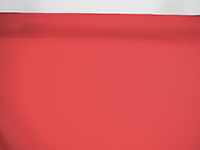
Flat
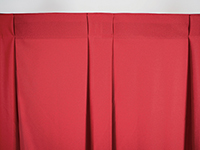
50% Box Pleats
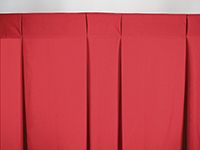
75% Box Pleats
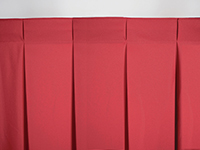
100% Box Pleats
I am hanging my theater drape from track. What are my top finish options?
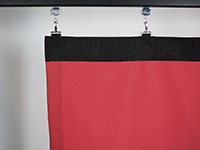
Webbing, Snap Hooks Above
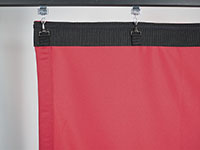
Webbing, Snap Hooks Flush
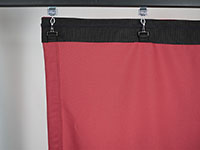
Webbing, Snap Hooks Below
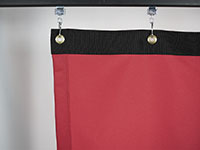
Webbing, Grommets, S-Hooks
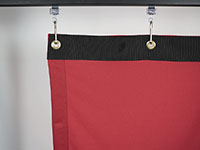
Webbing, Grommets, Elephant Ears
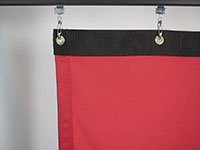
Webbing, Grommets, CCF-2s
I am hanging my theater curtain from track. What are my bottom finish options?
Typically, bottom hems are finished with a standard flat bottom hem, usually 6" for floor length curtains, and 3" for non-floor length curtains. The bottom hems are usually supplied with weight tape or a chain pocket, but can also be unweighted. See below for all bottom finishes.
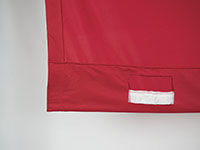
Weighted Hem, Weight Tape
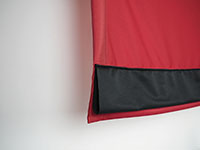
Weighted Hem, Pipe Pocket Behind

Unweighted Hem, Pipe Pocket Behind
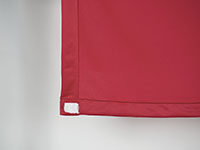
Weighted Corners
I am hanging my stage draperies from pipe. What are my top finish options?
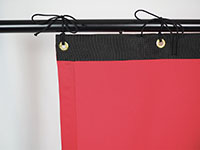
Webbing, Grommets, Ties
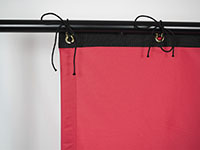
Webbing, Hidden Grommets, Ties
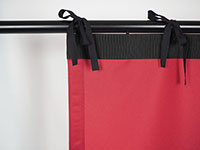
Webbing, Twill Ties Above
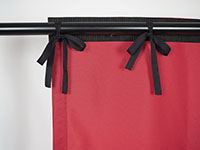
Webbing, Hidden Twill Ties
I am hanging my stage drapery from pipe. What are my bottom finish options?
Typically, bottom hems are finished with a standard flat bottom hem, usually 6" for floor length curtains, and 3" for non-floor length curtains. The bottom hems are usually supplied with weight tape or a chain pocket, but can also be unweighted. See below for all bottom finishes.

Weighted Hem, Weight Tape

Weighted Hem, Pipe Pocket Behind

Unweighted Hem, Pipe Pocket Behind

Weighted Corners
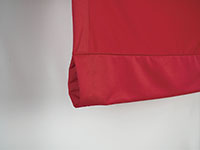
Pipe Pocket
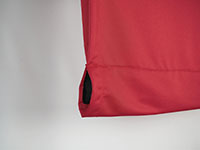
Suspended Pipe Pocket
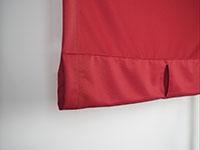
Pipe Pocket, Feed Slits
I am hanging my cyclorama from track. What are my top finish options?

Webbing, Snap Hooks Above

Webbing, Snap Hooks Flush

Webbing, Snap Hooks Below

Webbing, Grommets, S-Hooks

Webbing, Grommets, Elephant Ears

Webbing, Grommets, CCF-2s
I am hanging my cyclorama from track. What are my bottom finish options?
Typically bottom hems for cycloramas that are going to be hung from track are finished with either a 6" bottom hem, or a 4" bottom hem. The bottom hems are usually sewn with weight tape or a chain pocket, but can also be left unweighted. See below for all bottom finishes.

Weighted Hem, Weight Tape

Weighted Hem, Pipe Pocket Behind

Unweighted Hem, Pipe Pocket Behind

Weighted Corners

Pipe Pocket

Suspended Pipe Pocket

Pipe Pocket, Feed Slits
I am hanging my cyclorama from pipe. What are my top finish options?

Webbing, Grommets, Ties

Webbing, Hidden Grommets, Ties

Webbing, Twill Ties Above

Webbing, Hidden Twill Ties
I am hanging my cyclorama from pipe. What are my bottom finish options for this cyc?
Bottom hems for cycloramas that are going to be tied to pipe can be finished in several different ways... a pipe pocket with a hem or flap, a lined pipe pocket, a pocket with weight tape or chain, or an unweighted bottom hem. See below for all bottom finishes. For advice on the best way to finish your cyc, please contact us.

Weighted Hem, Weight Tape

Weighted Hem, Pipe Pocket Behind

Unweighted Hem, Pipe Pocket Behind

Weighted Corners

Pipe Pocket

Suspended Pipe Pocket

Pipe Pocket, Feed Slits
Should my theatrical drapery and window draperies be lined?
Most curtains can be lined if desired; however, you will typically find that main curtains and valances are lined to give the drapery a finished look. Lining also protects the curtain from damage caused by moving scenery and other objects which may snag the fabric. Linings can be either permanently sewn onto the main curtain, or be removable with hook and loop. Typically, cotton fabrics are lined with denim or Ranger lining, while IFR fabrics are lined with polyester. Window curtains and draperies are usually lined for sun protection and additional opacity.
What types of fabric can be used for printed backdrops?
Your artwork or image can be printed on a variety of different fabrics including muslin, canvas, vinyl, scrim, and velour. Please contact us for a recommendation based on your venue or needs.
What file formats do you accept for printed backdrop artwork?
We recommend delivering your artwork in native Illustrator (.ai), Photoshop (.psd), Adobe PDF (.pdf) or hi-res JPG.
Artwork requirements and upload instructions can be found here.
I recently purchased some stage curtain track, and I misplaced the installation instructions. Where can I find replacement instructions?
Complete installation instructions for all of our stage curtain track can be viewed and printed from the following link:
http://www.automaticdevices.com/installinstructions.cfm
Subcategories
